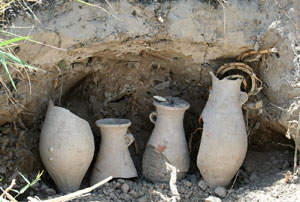 SHYMKENT – The sharp drop in water levels at the Shardara Reservoir, about 200 kilometres south-west from Shymkent, has had one benefit: it has led to the discovery of the remnants of an ancient settlement under the dried-up parts of the lake.
SHYMKENT – The sharp drop in water levels at the Shardara Reservoir, about 200 kilometres south-west from Shymkent, has had one benefit: it has led to the discovery of the remnants of an ancient settlement under the dried-up parts of the lake.
Local residents and fishermen first spotted the grass-covered hill, which the low water levels allowed them to access. Archaeologists have now been able to explore the site and are convinced that the mound holds evidence of an ancient city. Under a 10-metre water column they found not only pottery and human and animal remains, but also a clay water pipeline. Its tube goes deeper into the water, out to the middle of the reservoir.
Nurlan Smailov, director of the district museum, said that in 1958, archaeologists from Moscow and what was then called Alma-Ata conducted excavations on the island, which appeared just 50 metres from the shore of the reservoir. For five years, the scientists conducted digs on the fort, known as Aktobe-2, or “White Hill.” The name was chosen because the settlement had been built from white stones.
The scientists then found several scattered settlements dating to the middle ages. The construction of the Shardara Reservoir interrupted the excavations, and Aktobe-2, with the mounds of Aktobe-1 and Zhaushykum, fell into the flood zone and became part of a man-made lake bed. After that, there was little more that could be learned.
Smailov does not exclude the possibility that the water-washed skeletons could be the remains of ancient Kangly or Samanids (Turkic and Persian peoples), who came here after the fall of the Western Turkic Khanate. It is also possible that the Qarakhanids ruled there before the Mongol invasion. The founder of the Kazakh school of archaeology, academician Alkey Margulan, believed that these settlements dated back to the Kangly state that emerged in the third century B.C.
The falling waters may now allow archaeologists to return to the study of the region’s ancient cities and find answers to their questions about its ancient history. However, time will soon run out again: more water is set to fill the reservoir, and a unique ancient monument once again will be hidden under it.


